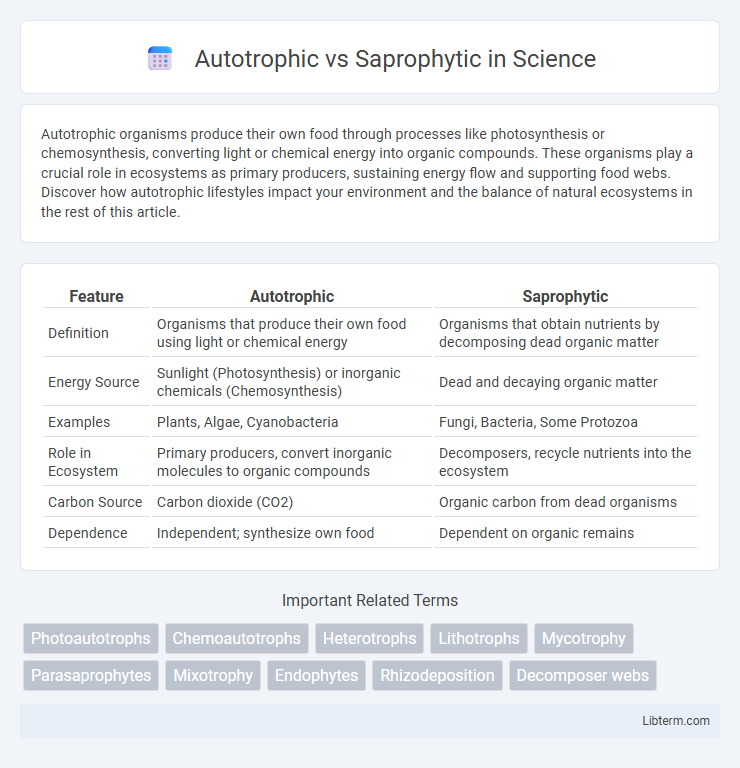Autotrophic organisms produce their own food through processes like photosynthesis or chemosynthesis, converting light or chemical energy into organic compounds. These organisms play a crucial role in ecosystems as primary producers, sustaining energy flow and supporting food webs. Discover how autotrophic lifestyles impact your environment and the balance of natural ecosystems in the rest of this article.
Table of Comparison
| Feature | Autotrophic | Saprophytic |
|---|---|---|
| Definition | Organisms that produce their own food using light or chemical energy | Organisms that obtain nutrients by decomposing dead organic matter |
| Energy Source | Sunlight (Photosynthesis) or inorganic chemicals (Chemosynthesis) | Dead and decaying organic matter |
| Examples | Plants, Algae, Cyanobacteria | Fungi, Bacteria, Some Protozoa |
| Role in Ecosystem | Primary producers, convert inorganic molecules to organic compounds | Decomposers, recycle nutrients into the ecosystem |
| Carbon Source | Carbon dioxide (CO2) | Organic carbon from dead organisms |
| Dependence | Independent; synthesize own food | Dependent on organic remains |
Introduction to Autotrophic and Saprophytic Nutrition
Autotrophic nutrition involves organisms like plants and algae producing their own food through photosynthesis, using sunlight, carbon dioxide, and water to create glucose and oxygen. Saprophytic nutrition is characteristic of fungi and certain bacteria that obtain nutrients by decomposing dead organic matter, releasing enzymes to break down complex substances externally before absorption. Both nutritional modes play vital roles in ecosystems by contributing to energy flow and nutrient cycling.
Key Definitions: Autotrophs vs Saprophytes
Autotrophs are organisms that produce their own food using light, water, carbon dioxide, or other chemicals through processes like photosynthesis or chemosynthesis. Saprophytes, on the other hand, obtain nutrients by decomposing dead organic matter, playing a crucial role in nutrient recycling within ecosystems. The primary distinction lies in autotrophs generating organic compounds from inorganic sources, while saprophytes rely on external organic material for energy and growth.
Types of Organisms: Examples of Autotrophs and Saprophytes
Autotrophic organisms such as green plants, algae, and cyanobacteria synthesize their own food through photosynthesis or chemosynthesis, using sunlight or inorganic chemicals as energy sources. Saprophytic organisms, including fungi like mushrooms and molds, as well as bacteria such as Bacillus and Pseudomonas, obtain nutrients by decomposing dead organic matter. These distinct nutritional modes play crucial roles in ecosystems by contributing to energy production and nutrient recycling.
Mechanisms of Nutrient Acquisition
Autotrophic organisms acquire nutrients by converting inorganic substances such as carbon dioxide and sunlight into organic compounds through photosynthesis or chemosynthesis, enabling self-sustenance. Saprophytic organisms obtain nutrients by secreting enzymes that decompose dead organic matter, absorbing the resulting simpler substances for energy and growth. These contrasting mechanisms reflect the fundamental ecological roles of autotrophs as primary producers and saprophytes as decomposers in nutrient cycling.
Energy Sources: Light, Chemical, and Dead Matter
Autotrophic organisms harness energy primarily from light through photosynthesis or from chemical reactions in chemoautotrophs, converting inorganic substances into organic compounds. Saprophytic organisms obtain energy by decomposing dead organic matter, breaking down complex molecules to absorb nutrients. The distinction lies in autotrophs producing their own food using light or chemical energy, while saprophytes rely on external dead material as an energy source.
Ecological Roles and Importance
Autotrophic organisms, such as plants and algae, play a crucial ecological role by producing organic matter through photosynthesis, forming the base of most food webs and sustaining ecosystems. Saprophytic organisms, including fungi and certain bacteria, decompose dead organic material, recycling nutrients back into the soil and maintaining ecosystem nutrient cycles. Together, autotrophs and saprophytes drive energy flow and nutrient cycling, supporting biodiversity and ecosystem stability.
Adaptations for Nutrient Uptake
Autotrophic organisms possess specialized chloroplasts and photosynthetic pigments like chlorophyll to efficiently capture sunlight and convert inorganic carbon into organic compounds, facilitating nutrient uptake through photosynthesis. Saprophytic organisms secrete extracellular enzymes such as cellulases and proteases to decompose dead organic matter, absorbing simpler molecules like glucose and amino acids directly from their environment. Structural adaptations in saprophytes include extensive hyphal networks in fungi, increasing surface area for enzyme secretion and nutrient absorption.
Autotrophic and Saprophytic Life Cycles
Autotrophic organisms produce their own food through photosynthesis or chemosynthesis, enabling continuous energy flow within their life cycle by converting inorganic substances into organic matter. Saprophytic organisms break down dead organic material, recycling nutrients back into the ecosystem, with their life cycle centered on decomposition stages that facilitate nutrient absorption and growth. Both life cycles are crucial for ecosystem stability, maintaining energy balance and nutrient cycling through their respective biological processes.
Impact on the Environment and Food Chains
Autotrophic organisms, such as plants and algae, produce organic matter through photosynthesis, forming the base of most food chains and sustaining energy flow within ecosystems. Saprophytic organisms, like fungi and decomposers, break down dead organic material, recycling nutrients back into the soil and maintaining ecosystem health and productivity. Both autotrophic and saprophytic processes are crucial for nutrient cycling and energy transfer, supporting biodiversity and ecosystem stability.
Comparison Table: Autotrophic vs Saprophytic Characteristics
Autotrophic organisms synthesize their own food using sunlight or chemical energy, featuring chlorophyll for photosynthesis and thrive in environments with light or chemical sources, whereas saprophytic organisms obtain nutrients by decomposing dead organic matter, lacking chlorophyll and typically inhabiting soil or decaying material. Autotrophs produce oxygen as a byproduct and form the base of most food chains, while saprophytes recycle nutrients, playing a key role in ecosystem nutrient cycles. Growth rates differ, with autotrophs relying on light or chemical energy availability, and saprophytes dependent on the presence of organic matter for energy and carbon sources.
Autotrophic Infographic

 libterm.com
libterm.com